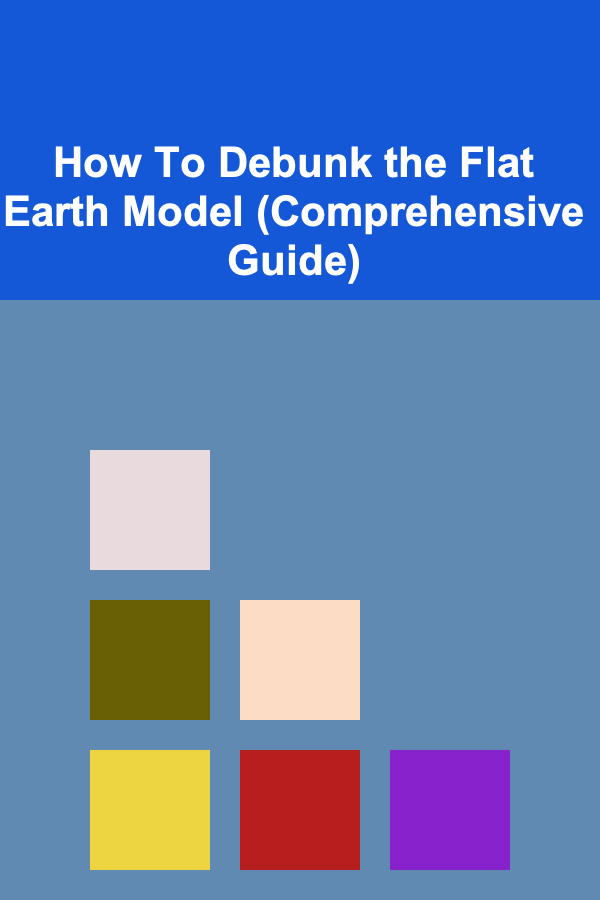
How To Debunk the Flat Earth Model (Comprehensive Guide)
ebook include PDF & Audio bundle (Micro Guide)
$12.99$7.99
Limited Time Offer! Order within the next:

The Flat Earth theory has persisted in various forms throughout history, despite overwhelming scientific evidence supporting the Earth's spherical shape. With the rise of social media and online communities, the Flat Earth movement has gained traction in recent years, even though the scientific consensus has long established that the Earth is an oblate spheroid. This guide will provide a comprehensive breakdown of the evidence that debunks the Flat Earth model, examining historical, physical, astronomical, and modern scientific observations.
Historical Context of the Flat Earth Model
The belief that the Earth is flat dates back to ancient civilizations, but even in antiquity, there were thinkers who proposed that the Earth was spherical. In the ancient Greek world, philosophers such as Pythagoras and Aristotle provided arguments based on observations of the stars and the Earth's shadow on the Moon during a lunar eclipse. These early theorists were among the first to challenge the idea of a flat Earth, laying the foundation for the scientific understanding of our planet's shape.
Despite early observations and writings in support of a spherical Earth, flat Earth beliefs have persisted due to cultural, religious, and philosophical factors. It wasn't until the Renaissance period, with advances in navigation and astronomy, that the spherical model became universally accepted. However, in modern times, the resurgence of the Flat Earth theory can be attributed to the spread of misinformation and skepticism toward scientific institutions.
Physical Evidence Against the Flat Earth Model
One of the most compelling ways to debunk the Flat Earth model is through physical evidence. Several simple observations and experiments show that the Earth's curvature is not only real but also observable.
2.1. The Horizon and Curvature of the Earth
One of the first signs of the Earth's curvature can be observed when watching a ship disappear over the horizon. As a ship sails away from the observer, it gradually disappears bottom first, with the hull vanishing before the mast or the top of the sail. This occurs because the Earth's surface is curved, and the lower parts of the ship are obscured as it moves farther away. On a flat Earth, the entire ship would shrink uniformly as it moved into the distance but would remain fully visible until it became too small to see.
Another simple piece of evidence is the way distant objects are obscured by the horizon. On a flat Earth, one could theoretically see much farther than is possible on a spherical Earth. In fact, a person on a flat plane should be able to observe a distant object that is located far below the line of sight. However, the curvature of the Earth prevents this.
2.2. The Earth's Shadow on the Moon
During a lunar eclipse, the Earth casts a shadow on the Moon. This shadow is always round, and this round shape can only be cast by a spherical object. A flat object, regardless of its size, would produce a shadow that changes shape depending on the angle of the light, but the Earth's shadow on the Moon remains consistent in its roundness. This provides clear evidence that the Earth is spherical.
2.3. Gravity and Weight Distribution
Gravity is one of the key forces that leads to the spherical shape of celestial bodies. The Earth's gravitational pull ensures that matter is pulled toward the center of the planet from all directions, forming a near-perfect sphere. On a flat Earth, the gravity would not be uniform. The gravitational force would pull objects toward the center of the flat disc, leading to noticeable discrepancies in weight distribution and effects on how objects move, which does not happen on Earth.
In fact, the observation of how objects fall --- perpendicular to the Earth's surface --- further confirms the Earth's spherical shape. If the Earth were flat, the force of gravity would not behave the same way across the entire surface, particularly at the edges of the flat disc.
2.4. Airplane Flight Paths
The flight paths of airplanes also debunk the Flat Earth model. Airplanes navigate using great-circle routes, which take into account the curvature of the Earth. If the Earth were flat, flight paths would be completely different, often requiring strange detours or backtracking, which would be inefficient and impractical.
For example, a flight from New York to Tokyo follows a curved path over the North Pole, which is a direct route on a spherical Earth. On a flat Earth, the flight would need to follow an entirely different path. The consistent use of great-circle routes in commercial aviation further supports the spherical model.
Astronomical Observations
Astronomy has provided some of the most compelling evidence against the Flat Earth theory. The behavior of celestial bodies, as well as the way stars and planets move across the sky, can only be explained by a spherical Earth.
3.1. The Earth's Rotation and the Day-Night Cycle
The rotation of the Earth is the primary cause of the day-night cycle. As the Earth rotates on its axis, different parts of the planet experience daylight while others experience night. The fact that we have a regular 24-hour cycle of day and night across the globe is evidence of the Earth's rotation and its spherical shape.
If the Earth were flat, it would be impossible for sunlight to only illuminate half the planet at a time. The Sun's light would be spread out differently, leading to strange patterns of daylight and night. The consistent and predictable pattern of day and night around the globe is only possible on a rotating, spherical Earth.
3.2. The Motion of the Stars and Planets
The stars and planets also behave in a way that supports the Earth's curvature. For instance, the constellations visible in the night sky shift as you travel north or south. On a spherical Earth, this is explained by the fact that your position relative to the celestial sphere changes as you move around the planet. If the Earth were flat, there would be no reason for the constellations to change position in the sky depending on your location.
In addition, the movement of the Sun, Moon, and planets follows predictable paths that align with a spherical Earth. The phases of the Moon, the appearance and disappearance of the Sun, and the movements of the planets all work within the framework of a heliocentric solar system, with the Earth orbiting the Sun.
3.3. Satellite Imagery and Space Exploration
Perhaps the most direct evidence of the Earth's spherical shape comes from satellite imagery and space exploration. Photos of the Earth from space, taken by astronauts and satellites, show the planet as a round sphere. These images provide a clear, unambiguous depiction of Earth's shape, and any claim that these images are faked is contradicted by the sheer volume of evidence provided by different space agencies around the world.
Additionally, the operation of GPS and communications satellites relies on the fact that the Earth is spherical. These satellites orbit the Earth in specific paths that are only possible if the Earth is round. If the Earth were flat, satellite orbits would be completely different, and GPS would not function as accurately as it does.
The Scientific Consensus
The scientific consensus on the Earth's shape is based on centuries of accumulated evidence from multiple disciplines, including astronomy, physics, geology, and geography. The overwhelming body of research and observation from a variety of independent sources demonstrates that the Earth is an oblate spheroid, not a flat disc.
One of the key aspects of the scientific method is that theories are tested, challenged, and refined over time. The spherical model of the Earth has been repeatedly tested through observation and experimentation, and it has consistently been validated. Flat Earth proponents often argue that the scientific community is part of a conspiracy, but this claim falls apart under scrutiny. Scientists from diverse backgrounds and cultures have contributed to the understanding of Earth's shape, and their findings are consistent with the evidence we observe today.
Addressing Common Flat Earth Arguments
Many Flat Earth claims are based on misunderstandings or misinterpretations of scientific principles. Let's address some of the most common arguments put forward by Flat Earth proponents:
5.1. The "Horizon Looks Flat" Argument
Flat Earthers often claim that the horizon looks flat when observed from a high point, such as a mountain or an airplane. However, this observation is due to the immense size of the Earth. From a human perspective, the Earth's curvature is not immediately apparent because it is so vast. As we look out across the horizon, we are seeing only a tiny portion of the Earth's surface, and the curvature is subtle.
5.2. The "Water Doesn't Curve" Argument
Flat Earth proponents also claim that water doesn't curve along the Earth's surface. However, this argument overlooks the principle of gravity, which pulls water toward the center of the Earth. The curvature of the Earth can be observed in large bodies of water, such as oceans, where the curvature becomes evident in the way ships disappear over the horizon and in the Earth's shadow during a lunar eclipse.
5.3. The "NASA Faked the Moon Landing" Argument
A common claim among Flat Earth proponents is that NASA faked the Moon landings and other space missions to conceal the true nature of the Earth. This theory ignores the vast amount of evidence from independent sources, including the numerous countries and private companies that have conducted space exploration. The idea that such an elaborate global conspiracy could be maintained for decades without any credible leaks or proof is implausible.
Conclusion
The Flat Earth model is a belief system that has been debunked through centuries of scientific observation and experimentation. From the curvature of the Earth to the motion of celestial bodies, every aspect of our world and the universe around us points to the Earth being an oblate spheroid. Modern technology, including satellite imagery and space exploration, has provided irrefutable evidence of the Earth's shape.
While the Flat Earth theory continues to attract a small but vocal following, it is clear that the scientific community's understanding of the Earth as a spherical object is based on overwhelming evidence from multiple disciplines. The persistence of the Flat Earth theory can largely be attributed to misinformation, misunderstanding, and skepticism toward scientific institutions, but the facts speak for themselves: the Earth is round.

How to Create a Budgeting Checklist for Software Implementation
Read More
How to Create a Pet Schedule for Feeding, Walks, and Playtime
Read More
How to Plan the Ultimate Game Night Party at Home
Read More
How to Save for a Vacation While Maintaining a Home Budget
Read More
How to Utilize Under-Bench Storage for Gardening Tools
Read More
10 Tips for a Budget-Friendly Birthday Party Planning Checklist
Read MoreOther Products

How to Create a Budgeting Checklist for Software Implementation
Read More
How to Create a Pet Schedule for Feeding, Walks, and Playtime
Read More
How to Plan the Ultimate Game Night Party at Home
Read More
How to Save for a Vacation While Maintaining a Home Budget
Read More
How to Utilize Under-Bench Storage for Gardening Tools
Read More